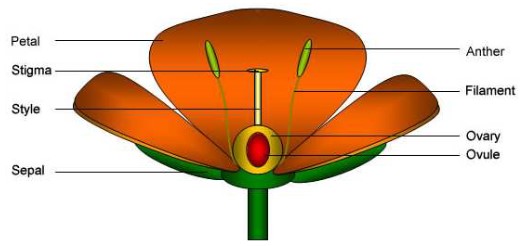Topic 9: Plant biology (HL)
9.4 Reproduction in plants
Structure of the flower
- Anther: create pollens
- Stigma: pollen landing site
- Style: where pollen tubes grow down
- Petals: for attraction
- Sepals: protecting growing flower
- Ovary: contains ovules (eggs)
- Filament: support for stigma

Control of flowering
- Photoperiodism is a plant’s response to light involving the lengths of day and night; which causes flowering in plants.
- It has been determined that the length of the night (darkness) not the length of the day (light) determines flowering in short-day and long-day plants.
- Phytochrome is the photoreceptor or a pigment that plants use to detect light.
- It is sensitive to light in the red and far red region of the visible spectrum.
- Two forms of phytochrome exist; \(P_r\) (inactive form) and \(P_{fr}\) (active form).
- \(P_r\) absorbs red light (660 nm) while \(P_{fr}\) absorbs far red light (730 nm) of the visible spectrum.
- During daylight hours when \(P_r\)absorbs red light it is converted to \(P_{fr}\) and when \(P_{fr}\) absorbs far red light it is converted back to \(P_r\). Because there is more red light in sunlight, during the daylight, there if a build-up of \(P_{fr}\).
- At night \(P_{fr}\) is slowly converted back into \(P_r\). Therefore after a long day of sunlight (summer), there will be more \(P_{fr}\) in the plant than after a short day of sunlight (winter).
- In long day plants (plants that flower in the summer) \(P_{fr}\) stimulates flowering, thus in the summer when there is a build-up of \(P_{fr}\), long day plants flower at the right time.
- In short day plants (plants that flower in the spring or autumn) \(P_{fr}\)inhibits flowering, thus preventing these plants from flowering in the summer months when the days are long

- Critical night length: minimum darkness needed to flower.
- In long day plants, such as iris, they only flower when day length reaches a critical period. \(P_{fr}\) builds up to a critical point
- In short day plants, such as chrysanthemum, they only flower when length below a critical period. \(P_{fr}\) falls below a critical point.
- Flowers, which allow the plant to sexually reproduce, develop from the shoot apical meristem and are called a reproductive shoot
- Temperature and day length (mostly period of darkness) can transform a leaf producing shoot into a flower producing shoot
- The amount of light a plant receives, play a role in the production of either inhibitors or activators of genes that control flowering
- In long day plants, the active form of the phytochrome pigment \(P_{fr}\), leads to transcription of a gene that controls flowering (FT gene)
- The FT mRNA is transported to the shoot apical meristem in the phloem, where it is translated into the FT protein
- The protein binds to a transcription factor, which turns on many flowering genes, thus converting the leaf producing meristem into a flower producing
reproductive meristem
Pollination:
- Pollination is the process in plants in which pollen grains (male gametes) are transferred to the female gametes (ovules contained within the carpel), thereby enabling fertilization and sexual reproduction.
- Seed dispersal is the movement or transport of seeds away from the parent plant. This decreases competition between parents and offspring and promotes diversity within the species. Seeds can be dispersed through gravity, wind, water and by animals.
- Mutualism is the relationship between two organisms, where both organisms benefit
- Sexual reproduction depends on the transfer of pollen stamen from one plant to the stigma of another plant
- Pollen can be transferred by wind and possibly water, but more commonly pollen is transferred by animals known as pollinators such as bees, butterflies, birds, and bats
- Pollinators gain food from nectar and the plant gains a method to transfer pollen to another plant to allow for sexual reproduction
Seed:
- Radicle: embryonic root
- Plumule: embryonic stem
- Micropyle: allow water to enter
- Scar: where the ovule to the ovary
- Testa: seed coat
- Germination: when seeds begin to grow.
- Water enters the seed through micropyle and activate the seed
- Hormones are activated, which will lead to the production of amylase.
- Amylase breaks down starch into maltose.
- Maltose is absorbed by plumuble and radicle.
- If the seed has a single leaf, it is monocot.
- If the seed has two leaves, it is dicot

